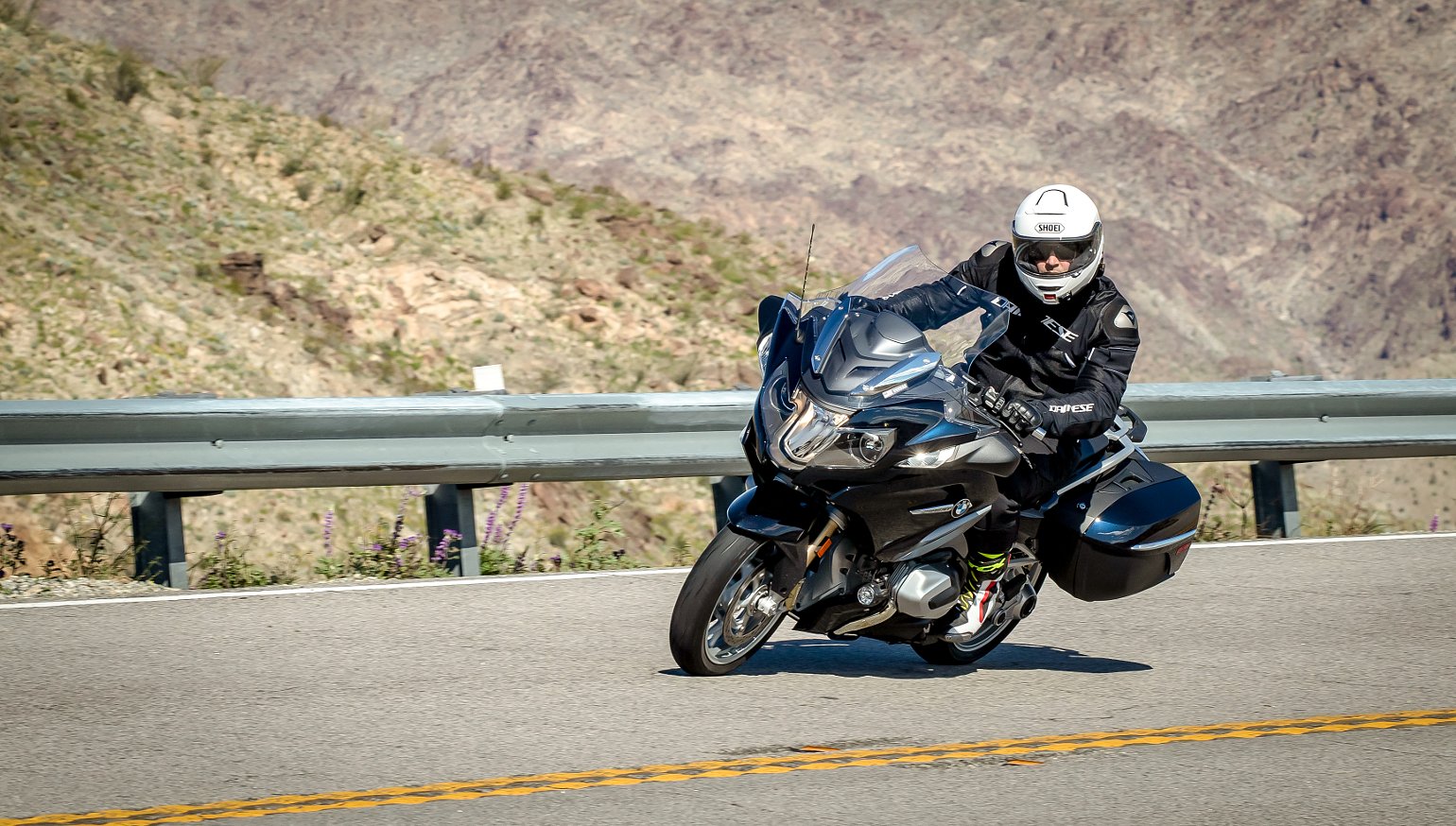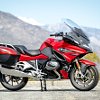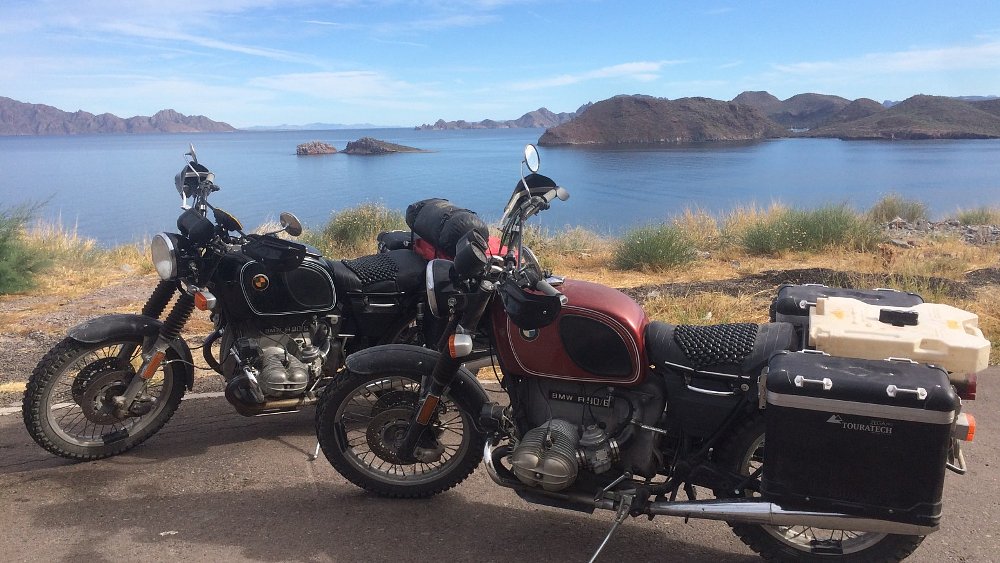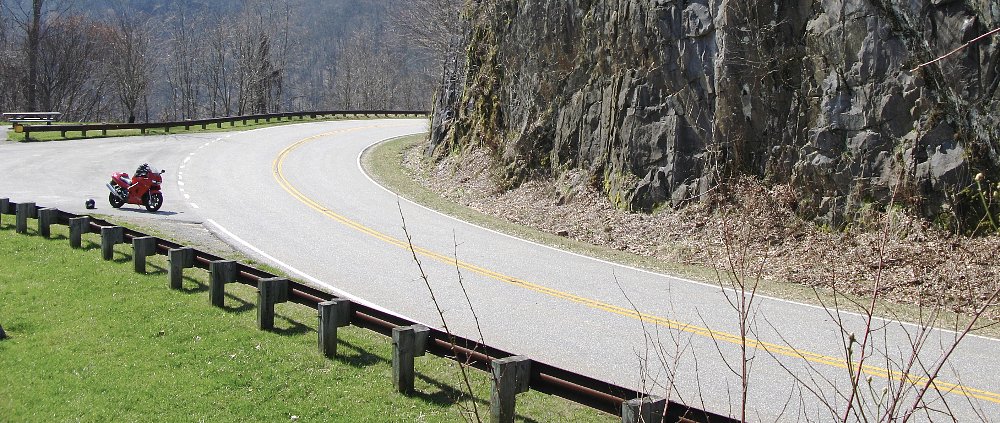The last time I found myself crossing the Anza-Borrego Desert I was atop a newly released Yamaha SCR950 on my way to Joshua Tree National Park in California in search of a ghost. The bike was comfortable enough for light touring but wasn’t exactly designed for blasting down a desert highway for hours on end at high speeds.
There was no windshield, my luggage was stuffed in a duffle bag strapped to the passenger seat, and the bike topped out somewhere around 90 mph. By comparison the 2019 BMW R 1250 RT I found myself piloting this time around was a luxurious rocketship.
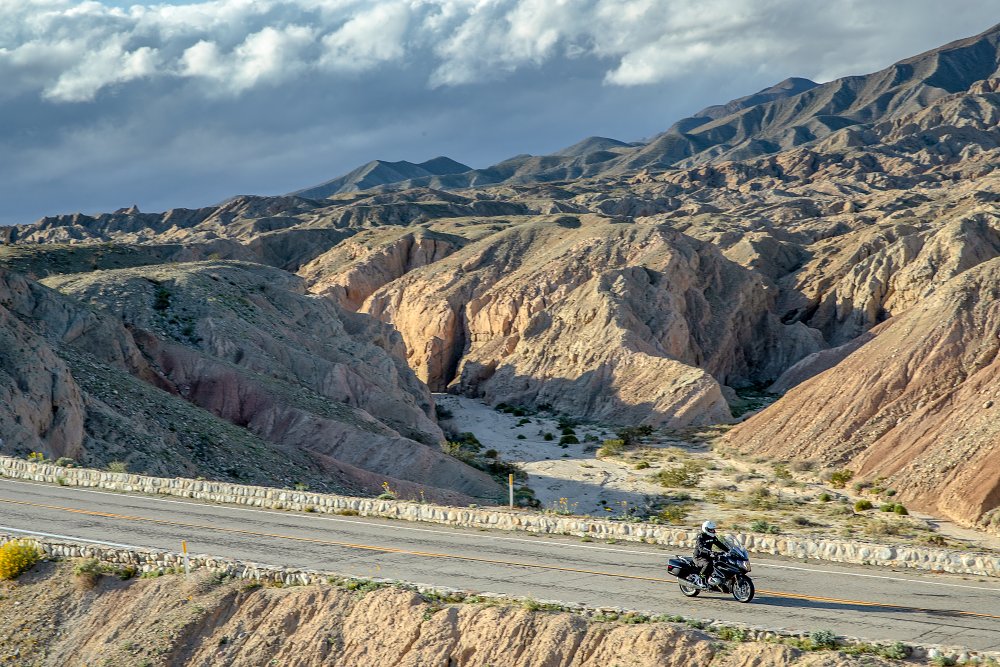
The RT has an electronically adjustable windshield, color-matched saddlebags that automatically lock with the push of a button, and it’ll break triple digits in third gear. And that's just getting started.
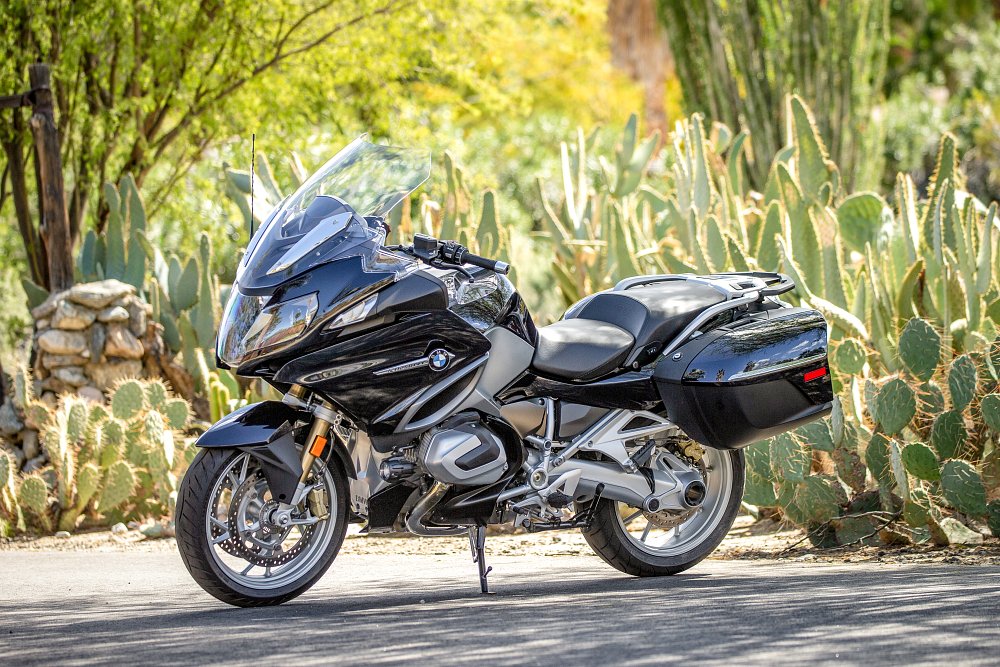
The BMW R 1250 RT
BMW presents the R 1250 RT as a lightweight, dynamic sport-tourer. Considering that the bike tips the scales at a claimed wet weight of nearly 610 pounds, this left a few of us scratching our heads. They went on to further explain that compared to their K 1600 lineup of bikes, which weigh in between 740 and 780 pounds, the new RT is, in fact, lighter.
This in turn sparked a debate between Zack Courts and myself about why folks would choose the RT over the more powerful K models. I argued in favor of the RT.
While the new ShiftCam boxer twin can’t touch the power of the huge 1,649 cc, 160-horsepower inline six-cylinder engine of the larger K bikes, it is lighter and easier to service, all while offering riders massive amounts of comfort and technology in line with what you can expect from larger touring machines.
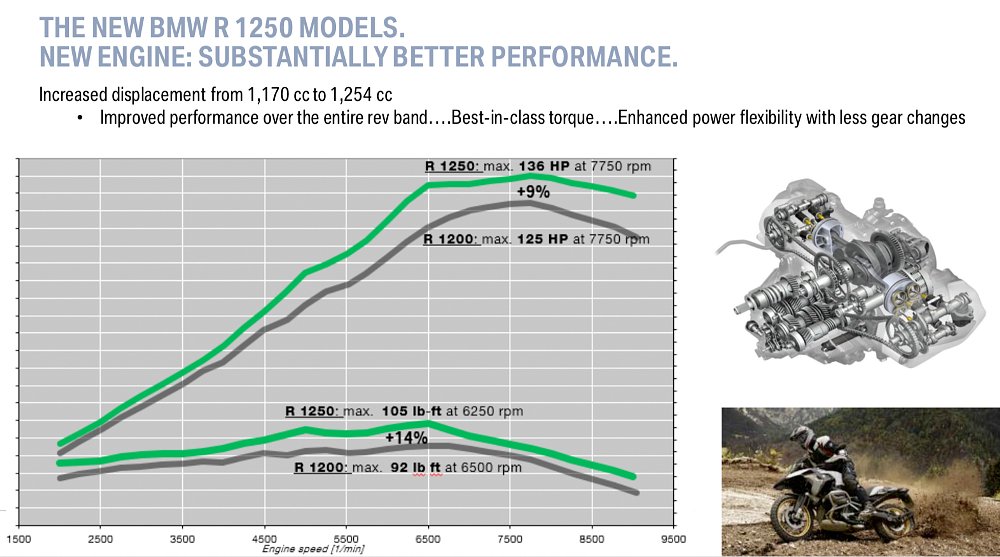
If you’re not familiar with the new 1,254 cc Boxer Twin, I’d recommend taking a look at the R 1250 GS article, in which I presented a rather in-depth look at the new engine, the same one utilized in the RT. What you need to know is that BMW is now claiming 136 horsepower at 7,750 rpm and 105 foot-pounds of torque at 6,250 rpm.
To achieve these gains, while also complying with the upcoming Euro 5 emissions requirements, a new ShiftCam system is used to introduce variable valve timing to the boxer twin. This system operates by actually “shifting” the intake camshaft in its seat to allow for the engagement of two different cam profiles.
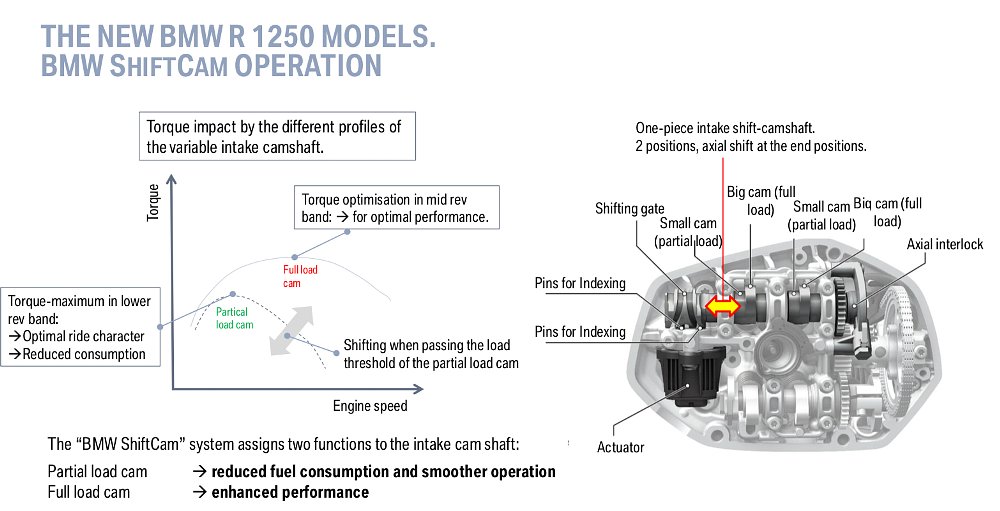
Below 5,000, rpm the “partial-load” cam offers lower lift and better fuel economy while over 5,000 rpm the system switches to the “full-load” cam, which provides better performance. The full-load cam can also be activated if the system senses a load being placed on the machine. As I mentioned in the previous GS review, the system worked flawlessly during our time with the bike and at no point did I notice the transition between the two profiles.
Service intervals remain the same with valve checks hitting every 12,000 miles. And as there are still only two cylinders jutting out the sides of the engine, maintenance is still much easier to perform on this motorcycle than on the six-cylinder Beemer.
The electronics package on the RT is nearly identical to the GS, as well. The newest feature is BMW’s “Hill Start Control,” which allows the rider to stop on a hill and have the bike hold itself in place until they’re ready to accelerate. The base version is activated by tapping the front brake twice when stopped, while the Pro version can automatically sense that the bike is on an angle.
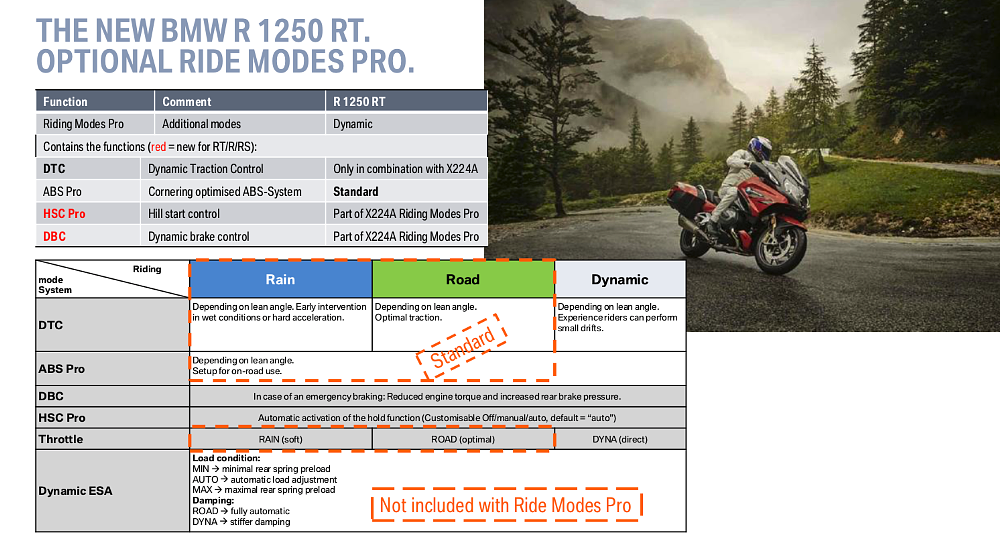
This is part of the Ride Modes Pro package, which adds a third Dynamic rider mode to the RT’s Rain and Road modes. The selected rider mode controls throttle response as well as the level of engagement from Dynamic Traction Control (DTC). Dynamic offers the most sporting performance and I preferred the throttle response in this setting.
Both DTC and ABS Pro are lean-angle sensitive. Adding Ride Modes Pro also includes BMW’s new Dynamic Brake Control (DBC). DBC will automatically roll off the throttle in panic stop situations in case the rider accidentally keeps the throttle on while grabbing a handful of front brake.
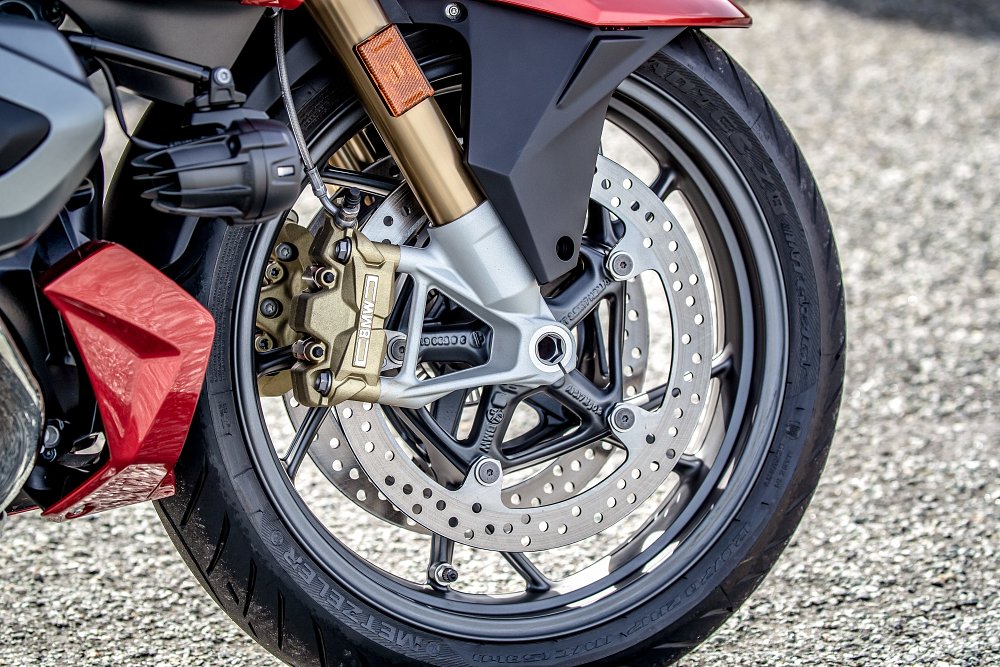
As with the GS, the front brake calipers on the RT are now manufactured by Hayes and are branded as BMW units. Dual, four-piston calipers up front clamp down on floating 320 mm rotors. The rear brake is a single Brembo dual-piston caliper paired with a 276 mm rotor. As with the GS, braking is phenomenal.
The RT is equipped with Next-Generation Dynamic ESA with Auto-Ride Height Adjustment and AutoDamper settings. This is different from earlier versions of BMW’s active suspension in the fact that the preload adjustment can also be automated. You can choose to maximize or minimize the setting, but if you want nothing to do with suspension tuning you can set the system to automatic and it will determine preload settings based on the amount of rider weight and luggage it senses.
You can then alternate between Road and Dynamic settings for the damping. Road features fully automatic damping tuned for comfort and Dynamic offers a sportier ride with stiffer damping. The front suspension is a BMW Telelever unit with a 37 mm central spring strut and 4.7 inches of travel and the rear BMW Paralever single-sided swingarm features a WAD strut with 5.4 inches of travel.
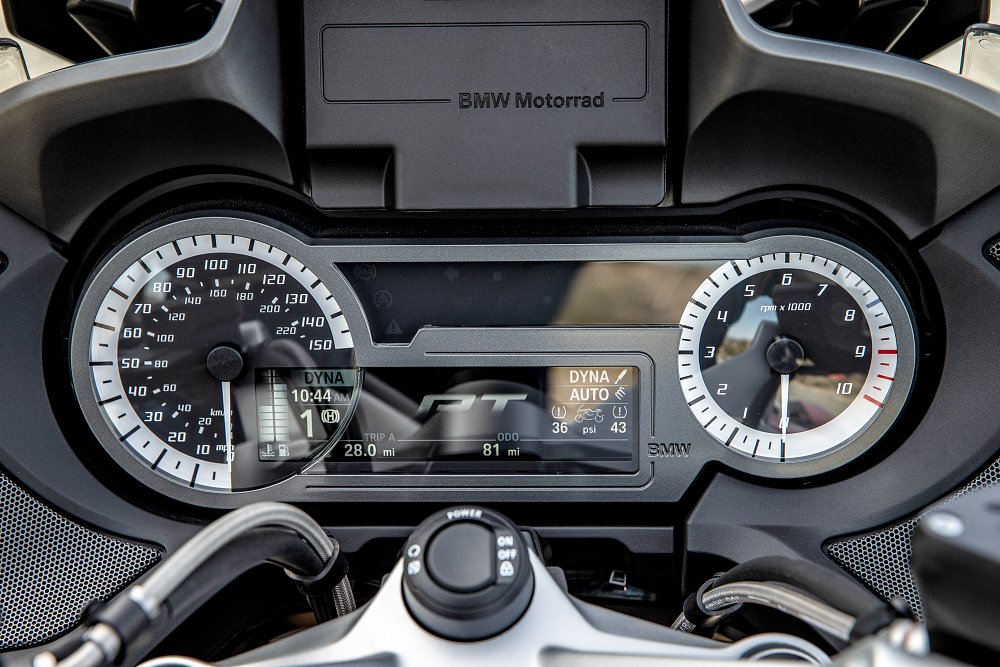
Unlike the GS and GSA, which feature a large TFT dash, the RT combines a large analog speedo and tach with a smaller digital readout. While I am sure there are a lot of people out there who will dig the classically styled readout, I am equally sure there will be some folks who would prefer the large TFT display off of the GS. Personally, I don’t mind the RT’s setup, but some of the functionality isn’t very intuitive.
For example, there is a button on the right handlebar control pod to lock the built in saddlebags, but the controls for the heated grips and heated seat have been moved to a setting inside the digital dash that requires multiple steps to access. The same goes for the suspension adjustment setting. This proved to be distracting while riding and riders won’t always have an opportunity to pull over to turn on the heated grips.
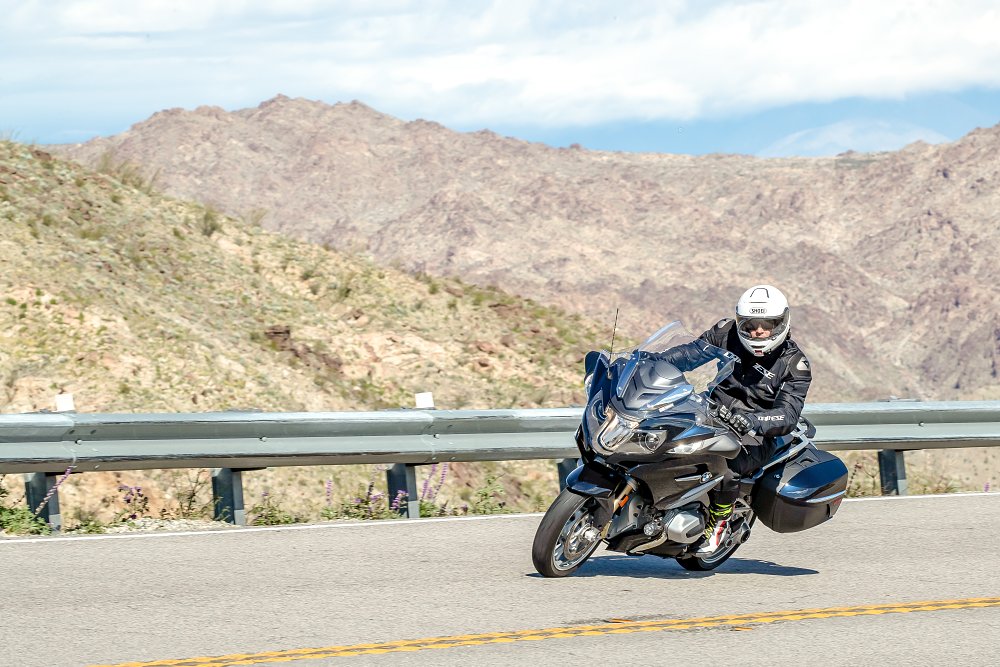
Riding the R 1250 RT
The sun was shining and temperatures were already in the low 70s as we pulled away from our Palm Springs hotel shortly after 8 a.m. Some reports suggested rain, but there wasn’t a cloud in the sky as I cracked the throttle and worked my way through the six-speed gearbox on the RT, an effort aided by Gear ShiftAssist Pro, BMW’s fancy name for a quickshifter.
While the engine is identical to the GS and GSA I had ridden the day before, the gearing felt taller. I was able to run the gears and stretch out the shift points. The RT prefers to be ridden for long distances at fast speeds as long as the road doesn’t get too curvy.
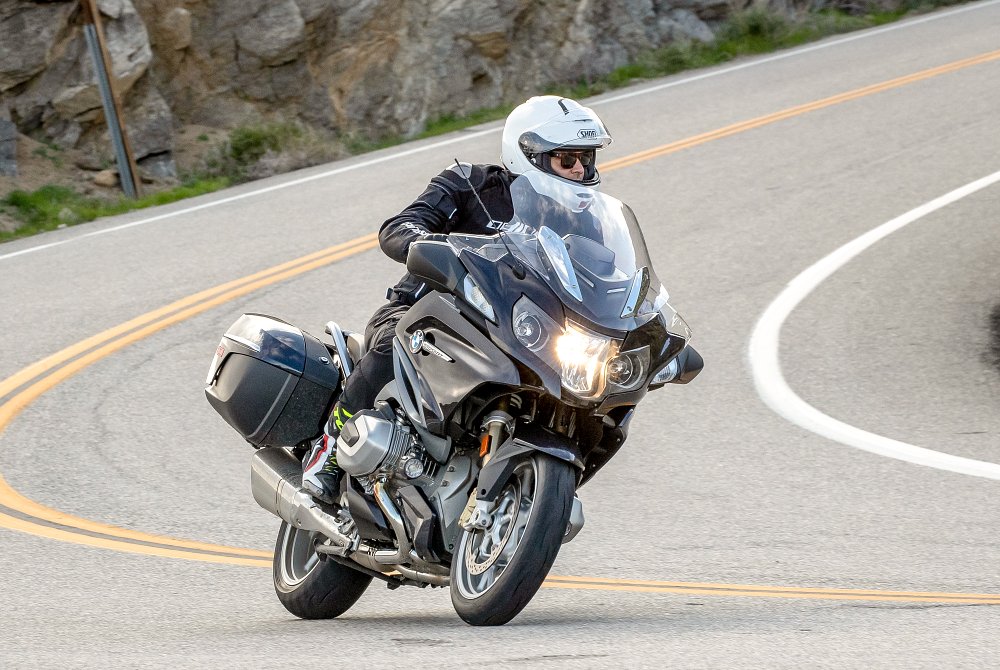
We left the desert below us and climbed Highway 74 into the mountains where the road snaked its way through the peaks. Compared to the GS, which attacked the corners, the RT seemed to wallow its way through. When we reached the first photo stop, I dove into the suspension settings and switched from Road to Dynamic damping and maxed out the preload.
This adjustment helped, but at no point throughout the day did I feel fully confident pushing this bike through the corners. Despite having a more sporting geometry than the GS when looking at the spec sheet, I felt like the GS cornered much better. Where the GS kind of just fell into the corners, the RT almost needed to be wrestled through them.
Once the road straightened out, the RT came into its own. It prefers long sweeping curves and highway miles to tighter, sportier roads.
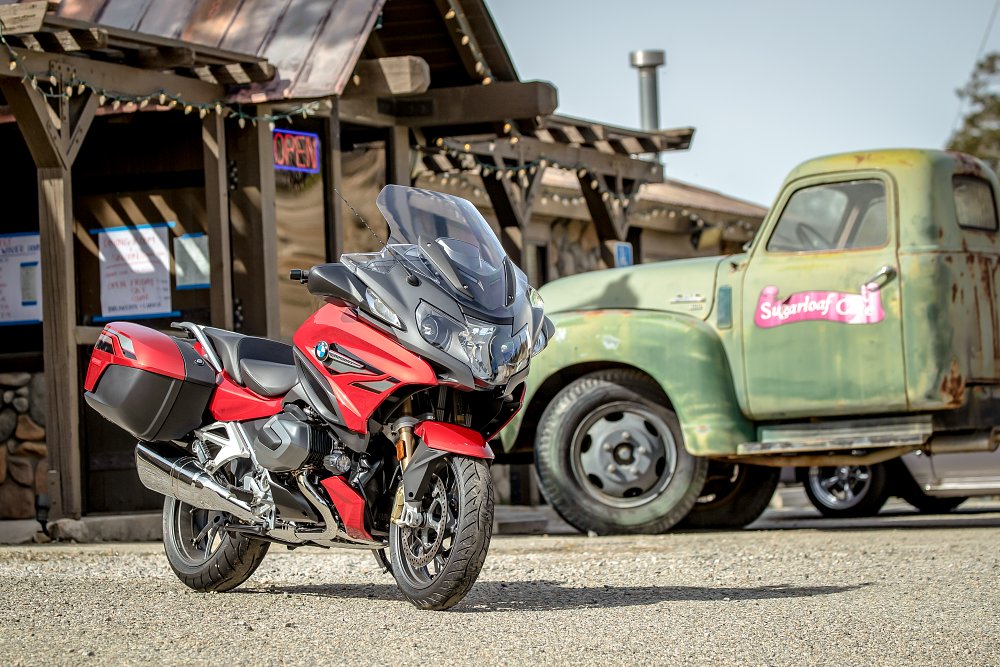
About two hours into our ride, we stopped for a cup of coffee at the Sugarloaf Cafe. If Lemmy had been doing this review, I can promise you he would have made a note to include it in one of his infamous “Brap Brap, Nom Nom” articles.
The sky began to darken over the mountains as we got back on the bikes. It wasn’t long before we were getting pelted by fat drops of rain as the wind shifted and we found ourselves riding into the heart of the storm. Temperatures dropped as our altitude increased.
My Dainese Dinamica jacket had its rain liner installed but my New Drake Air pants and TCX boots are not waterproof. Aside from my boots getting a little wet, the RT’s windshield and fairing kept me rather dry. I found that I preferred the windshield all the way down when it was dry, but setting it just shy of fully extended kept the rain off of me and didn’t cause wind buffeting.
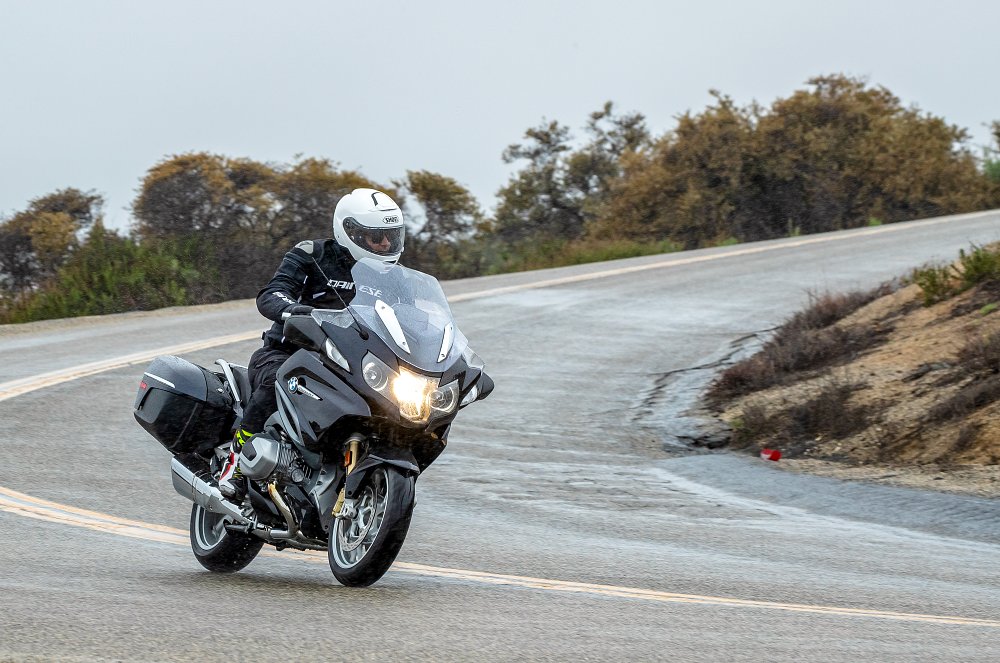
I switched the bike into rain mode and attempted to turn the heated grips up a notch or two. I found this task to be a bit too confusing to attempt while riding down a slick mountain road trying to keep up with the rest of our group. I waited until lunch to figure that one out.
Ergos were extremely comfortable, if not a little too upright for my personal taste. I prefer the “sport” side of sport-touring. My 1999 Honda VFR800 was one of my favorite bikes. The RT is more relaxed in its nature, favoring instead the “touring” characteristics of this segment of bikes. Looking at the pictures, I found it comical how my six-foot, three-inch frame made the RT look to be about an average-size motorcycle. It’s not.
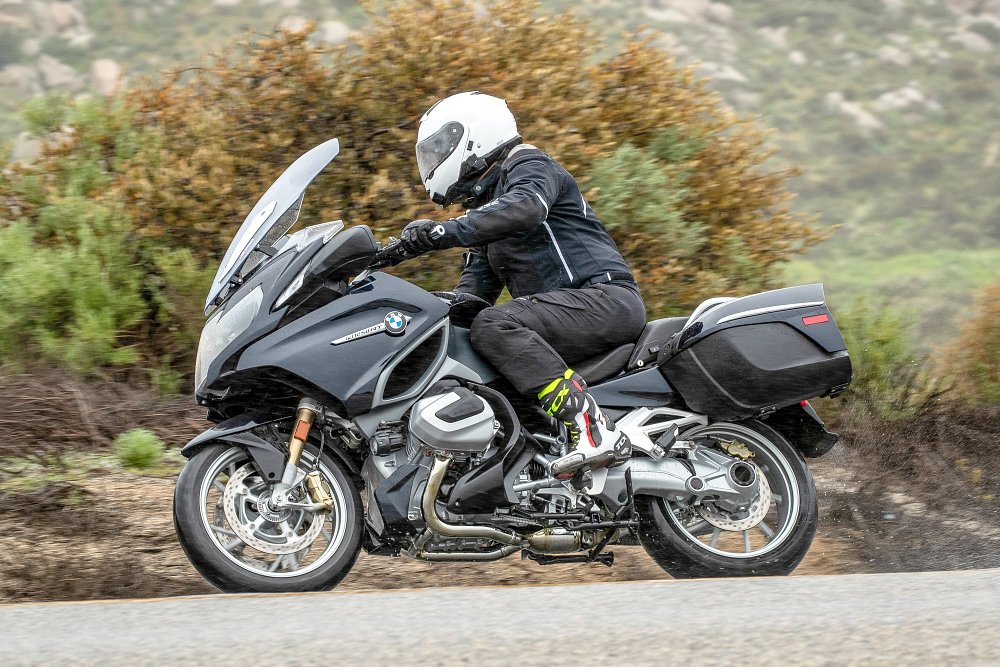
The RT is a rather large bike that provides plenty of comfort for rider and passenger. The new boxer engine pulls strong across the rev range and has plenty of oomph to haul rider and passenger at any speeds you’d want to go. Low-speed, parking-lot manners are a bit iffy if you’re trying to shuffle it backwards on a slick surface.
I normally couldn’t care less about fuel economy, as I prefer to run the gears long and keep the bike in the power. However, in the interest of our readers, I spent the second half of the day short-shifting across the desert on the Borrego Salton Seaway. The RT will hold 80 mph and still offer about 44 mpg. With a 6.6-gallon tank, touring riders should expect to have to start looking for a gas station around 250 miles or so. That is if you can go that long without wanting to stop for a bathroom break.
Pricing and competition
The R 1250 RT’s pricing structure is slightly easier to decipher than that of the GS, as it only has one package option. The base MSRP is $18,645, however, most bikes will only be imported with the “Select Package.” The Select Package ($5,150) offers the following add ons: Next-Gen ESA, Keyless Ride, Headlight Pro (BMW’s adaptive headlight technology), Gear ShiftAssist Pro, Ride Modes Pro with Dynamic Mode, Hill Start Control Pro, and Dynamic Brake Control, Audio System with Sirius Satellite Radio and Bluetooth, GPS Prep, Chrome Exhaust, Central Locking System, heated seat, TPM, cruise control, LED Aux lights, anti-theft alarm, and dual accessory sockets.

In addition to that, there are also different style packages that riders can choose from. As our bikes were equipped with all the goodies and a variety of style packages, prices ranged from $23,795 for the Alpine White with just the Select Package up to $25,595 for either the Sparkling Storm Metallic or Blue Planet Metallic with the Option 719 style package. You should also expect to see a $495 shipping fee associated with these bikes.
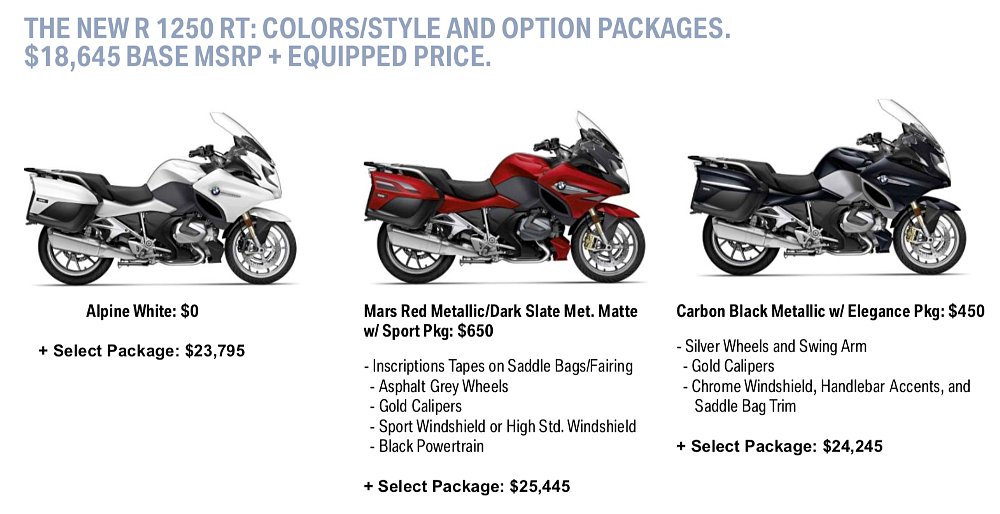
Competition for the RT is a bit hard to define as the touring segment has become so splintered. I think BMW would want us to compare this against something from their K 1600 lineup. And if you’re looking at the flagship GTL you can expect to pay somewhere around $29,000 for the base color option with the Select Package included. That puts it roughly $5,000 above the RT (depending on configuration). While you’ll gain roughly 25 horsepower, you’ll also gain about 160 pounds.
But if I were looking in BMW’s lineup for a touring bike, I’d rather have the R 1250 GS or the R 1200 RS. Having ridden the GS and GSA a day earlier, I found them to be much sportier in their performance while still providing plenty of long-distance riding comfort. Arguably, I am not taking the style of the bikes into play. For folks who want more of the sport-touring look, the RS is arguably a sportier sport-tourer than the RT. It is stripped of some of its comfort and focuses more on performance. I also would expect to see this bike updated with the 1250 motor sooner than later.
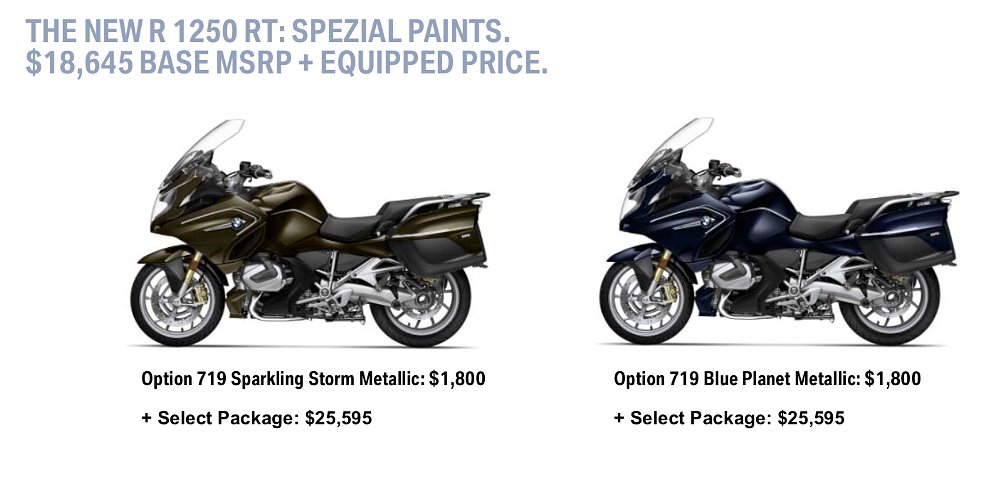
For folks looking for big bike, sport-touring luxury and comfort, a lot of the competition outside of BMW’s own lineup has disappeared. Triumph’s Trophy is no longer available and the Ducati SuperSport and KTM Super Duke GT are arguably aimed toward the RS, not the RT. Another slightly different sport-touring option is the Kawasaki H2 SX SE+, which offers a raft of electronics to go with a boatload of power and costs $25,000 for 2019. That leaves Yamaha’s FJR1300 and Honda’s newly revised Gold Wing.
I would argue the base Gold Wing at $23,800 would be a bike that a lot of customers would be cross shopping against the RT. I think with the new Wing Honda has introduced a lot of great technology like Apple CarPlay via the TFT dash, but BMW is still the better bike for the tech hungry rider and it’s still a bit more performance focused. At $17,999, the Yamaha FJR1300 is only an RT competitor if someone is willing to sacrifice on technology to save on price.
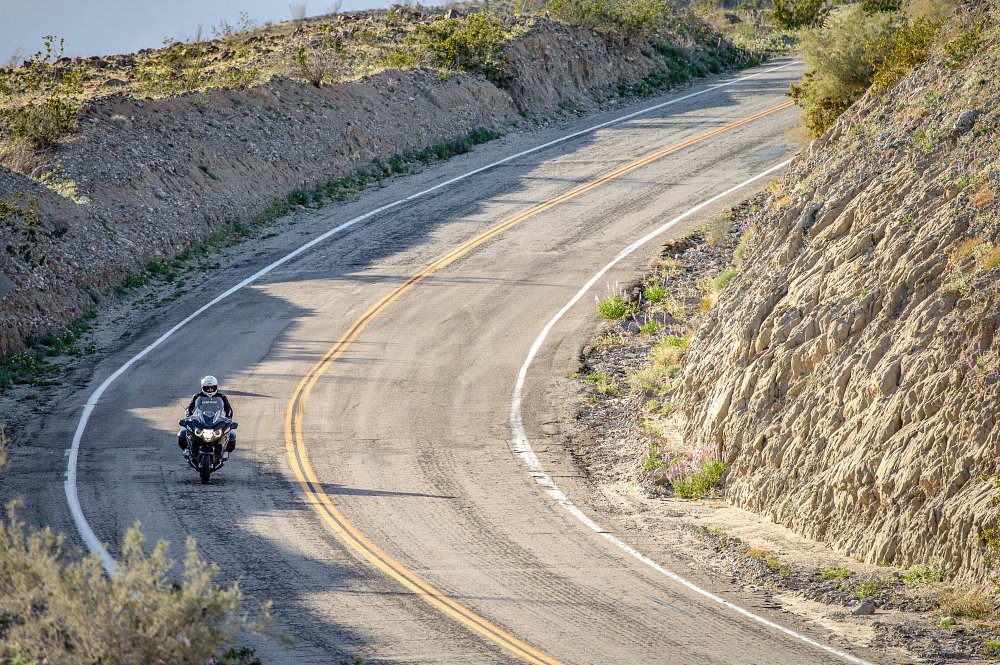
Conclusion
The Anza-Borrego Desert hadn’t changed at all since I was there in 2016, but my motorcycle sure had. Unlike my last trip, when I showed up to my hotel a bit beat up from a 200-mile trek across the desert, this time I arrived in complete comfort. That’s a testament to the touring abilities of the RT. While this bike is a bit too comfortable for my personal needs, there are a lot of riders out there who will appreciate the level of luxury the RT provides.
The RT is one of the best-selling best bikes in BMW’s lineup, so it was important to those in charge to make sure that it retained the characteristics of what has made it so popular while offering upgrades to ensure its relevance moving forward.
I told Zack Courts that I would choose the RT over the power of the K bikes because of the engine. The boxer twin is a unique engine full of character and charisma. It’s got a history, a story to it. BMW continues to iterate on the boxer, allowing a classic engine to live on in the modern age of emissions restrictions and governmental safety requirements. The engine is better than ever, and in turn, so is the bike. If you’re considering a luxury-focused, sport-touring machine, the RT continues to deliver.
| 2019 BMW R 1250 RT | |
|---|---|
| Price (MSRP) | $24,245 (as tested) |
| Engine type | Air/liquid-cooled, four-stroke flat twin, DOHC, BMW's ShiftCam variable engine timing system |
| Displacement | 1,254 cc |
| Bore x stroke | 102.5 mm x 76 mm |
| Compression | 12.5/1 |
| Power (claimed) | 136 horsepower @ 7,750 rpm |
| Torque (claimed) | 105 foot-pounds @ 6,250 rpm |
| Transmission | Six-speed |
| Front suspension | BMW Telelever, 37 mm, central spring strut |
| Rear suspension | Cast aluminum single-sided swingarm with BMW Paralever; WAD strut, dynamic suspension adjustment |
| Suspension travel front/rear | 4.7 inches / 5.4 inches |
| Front brake | Four-piston, fixed BMW-branded Hayes calipers |
| Rear brake | Dual-piston Brembo caliper |
| Tires front/rear | 120/70ZR17; 180/55ZR17 |
| Rake | 25.9 degrees |
| Wheelbase | 58.5 inches |
| Seat height | 31.7 - 32.5 inches |
| Tank capacity | 6.6 gallons |
| Wet weight (claimed) | 615 pounds |




